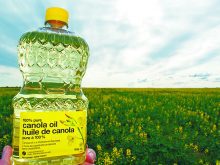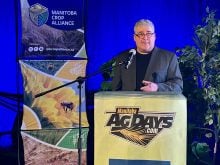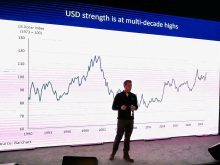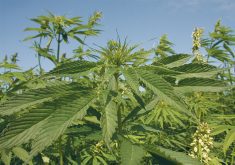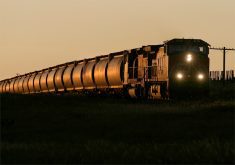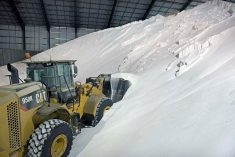Speakers often spout platitudes about farmers already operating at peak efficiency. There was lots of that kind of talk at Manitoba Ag Days last week.
But there were also bizarre bits of contradicting information that popped out during the dozens of presentations, speeches and discussions that thousands of farmers attended over the three-day event.
Did you know that less than 30 percent of Manitoba farmers (who answered a recent survey) say they understand and employ 4R fertilizer practices? That’s surprising after years and years of talk and education and promotion and advertising for 4R.
Read Also

Government, industry seek canola tariff resolution
Governments and industry continue to discuss how best to deal with Chinese tariffs on Canadian agricultural products, particularly canola.
Did you know most Manitoba farmers don’t change their fertilizer application rates (for the same crop) field to field? They just go with a “wheat rate,” a “canola rate,” etc. Presumably few of them do much in the way of soil testing because soil tests would encourage different rates for different fields based on the situation under the surface.
This isn’t to suggest farmers are lazy or irresponsible or intentionally wasteful, but it highlights the fact that there are areas in production and crop management where big efficiency gains can still be made. We’re not near peak efficiency yet.
If you’re the sort of farmer who’s reading this, you’re more likely to be further up the efficiency curve than those who don’t read farm newspapers and other agricultural materials. If you’re the sort of farmer who attends agronomic sessions at farm shows, you’re most likely well-aware of 4R and other much-touted efficiency practices.
But even the best producers have areas of production, management and marketing that they could improve upon. There’s real money to be made from operating at a higher level of efficiency. If everybody could gain a bit more efficiency, the financial and environmental benefits for Canadian agriculture would be huge.
Some people might have turned away from hearing about 4R because they associate it with federal government efforts to slash greenhouse gas emissions from farm fertilizer by 30 percent. Whether a farmer accepts that climate change is occurring and is caused by carbon emissions, few are likely to make “saving the planet” a top priority in their approach to farming. Profitability, financial sustainability and the practical ability to seed, manage and harvest a crop are always going to trump less make-or-break issues.
But that’s where big gains can be made in operating efficiency. With so many farmers unsure about 4R, or not yet trying to be hyper-efficient, there is much low-hanging fruit to pluck.
First, though, the farmers who don’t worry much about fertilizer efficiency need to start caring.
That’s not going to happen from climate crusaders preaching at farmers that they need to do things differently to save the world. It could happen if farmers are convinced they’re throwing money and profitability away with every kilogram of nitrogen lost from the soil.
The farm management team at Manitoba Agriculture has just released a fertilizer efficiency calculator that directly connects application efficiency with yields and profitability. The calculator looks at various fertilizer options, fertilizer costs, and crop returns. Instead of focusing upon nitrous oxide emissions as an environmental issue of indirect impact on the farmer, it looks at fertilizer wasted through inefficient utilization and connects that to cost and profitability.
Farmers don’t intentionally waste fertilizer, but much is wasted by applications that let nitrogen escape rather than feed a crop. Most farmers probably don’t realize just how great those losses can be and how that devastates profitability, but at today’s fertilizer prices, many people are beginning to think about it.
Farming with a focus on profit can be a big part of the solution to getting near the federal target of slashing greenhouse gas emissions from fertilizer. It isn’t in conflict with the goal of reducing emissions, but just needs to be understood as an issue of efficiency and profit, rather than seen as a cost and crimp on production for no direct benefit.
Those who want to see farmers cut their emissions needs to help them save money and make more profit if they want farmers to sign on to the program. The moralistic language and denunciatory tone of much climate change rhetoric needs to be toned down and replaced with language that makes sense to farmers striving to survive in a perilous business.
There’s more low-hanging fruit out there too, but that needs to be plucked by the governments who say they want to see farmers reduce their GHG emissions. And rather than criticize farmers, they will need to pony-up their cash and invest in agriculture if they want it.
Most farmers could slash their overall GHG emissions if they could get pulse crops and soybeans into their rotations or increase their proportion in the rotation. Pulse crops and soybeans fix nitrogen, eliminating much need for supplemental fertilizer.
But thousands of farmers can’t grow pulse crops and soybeans at all or anywhere near as often as they’d like due to problems with diseases like aphanomyces and incoming pests like soybean cyst nematode. Others farm in areas where the soil or climate doesn’t support pulse production with existing varieties.
We’ve seen corn and soybeans storm southern Manitoba and begin moving west out of the Red River Valley. That’s the result of investments in crop variety development that have produced varieties that can handle a short growing season and a low number of growing degree days. If farmers have the chance to grow money-making, rotation-aiding crops like soybeans, they will.
Getting our traditional pulse crops out of their limited present territory and helping soybeans move west would give thousands of farmers better rotations, free nitrogen fertilizer and a better chance at long-term profitability and survival. It would also cut dozens of percent of GHG emissions from farming.
If the federal government wants farmers to cut GHG emissions from crop farming, it needs to focus on how to help farmers make more money by wasting less fertilizer.
And if it wants to see enormous cuts to GHG emissions due to the elimination of fertilizer from one out of three years of cropping, it will need to put up the cash and pay for pulse and soybean variety research and development beyond anything the private sector is willing to support.
Farmers want to be efficient. They’ll be the best stewards of the environment if they can see how that builds them the best farm possible.
The tragedy of climate change talk is that it has alienated many farmers. Climate-talkers might need to swallow some humble pie and start talking to farmers in the language they speak. It might not seem as exciting to talk about efficiency and profitability as it is to paint pictures of environmental apocalypse, but it’s more likely to save the environment.






